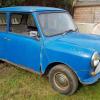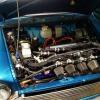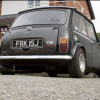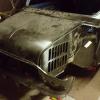Measuring castor is fairly straightforward and not a black art as some would have you believe.
The greater the caster angle then the more the camber angle will change with steering input. You therefore need to be accurately able measure to things.
1. Camber angle (or change of - i.e. relative values are important not absolute)
2. Steering turn angle
Now the values are linked with the following formula:
Change of camber angle = castor angle x sine (change of steering angle)
So set you car up with wheels straight ahead (not strictly necessary but does mean you'll have a decent range of movement) then turn 20° to the left (20° for the wheel you're measuring that is as each wheel will turn different amounts). Measure the camber angle. Then turn the wheel 40° to the right. Measure the camber.
Re arrange the above formula gives:
Castor angle = Change of camber angle/sine (change of steering angle)
So say that your camber is 1° one way and -3° the other then the change is 4°.
Sine 40° = 0.643. 4° divided by this figure gives 6.2°. This is your castor angle in the above example.
As long as the camber on the wheel when it is turned so it is on the outside of the turn has less positive (or more negative) camber then when the same wheel is turned so it is on the inside of the turn then you have positive camber.
With this method you can turn your steering through any measured angle, not just 40° as I have used in the worked example. The more the better however as it reduces measuring error.
EDIT
Note that 1/sine 40° = 1.55 so if 40° is your turn angle (20 either side of straight ahead) you can simply multiply your change in camber by 1.55 to give your castor angle.
For 30° (15 + 15) the relevant figure is 2
For 20° (10 + 10) the relvant figure is 2.92.
Edited by Swift_General, 18 August 2015 - 01:38 PM.





















